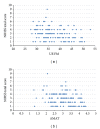Stroke Survivors Scoring Zero on the NIH Stroke Scale Score Still Exhibit Significant Motor Impairment and Functional Limitation
- PMID: 24772367
- PMCID: PMC3977106
- DOI: 10.1155/2014/462681
Stroke Survivors Scoring Zero on the NIH Stroke Scale Score Still Exhibit Significant Motor Impairment and Functional Limitation
Erratum in
- Stroke Res Treat. 2014;2014:542638
Abstract
Objective. To determine the National Institutes of Health Stroke Scale's (NIHSS's) association with upper extremity (UE) impairment and functional outcomes. Design. Secondary, retrospective analysis of randomized controlled trial data. Setting. Not applicable. Participants. 146 subjects with stable, chronic stroke-induced hemiparesis. Intervention. The NIHSS, the UE Fugl-Meyer (FM), and the Arm Motor Ability Test (AMAT) were administered prior to their participation in a multicenter randomized controlled trial. Main Outcome Measures. The NIHSS, FM, and AMAT. Results. The association between the NIHSS and UE impairment was statistically significant (P = -0.204; p = 0.014) but explained less than 4% of the variance among UE FM scores. The association between NIHSS total score and function as measured by the AMAT was not statistically significant (P = -0.141; p = 0.089). Subjects scoring a "zero" on the NIHSS exhibited discernible UE motor deficits and varied scores on the UE FM and AMAT. Conclusion. While being used in stroke trials, the NIHSS may have limited ability to discriminate between treatment responses, even when only a relatively narrow array of impairment levels exists among patients. Given these findings, NIHSS use should be restricted to acute stroke studies and clinical settings with the goal of reporting stroke severity.
Figures
References
-
- American Heart Association. Heart Disease and Stroke Statistics—2013 Update. American Heart Association; 2011.
-
- Kelly-Hayes M, Beiser A, Kase CS, Scaramucci A, D’agostino RB, Wolf PA. The influence of gender and age on disability following ischemic stroke: the framingham study. Journal of Stroke and Cerebrovascular Diseases. 2003;12(3):119–126. - PubMed
-
- Gresham G, Fitzpatrick T, Wolf P, Mcnamara P, Kannel W, Dawber T. Residual disability in survivors of stroke—the framingham study. New England Journal of Medicine. 1975;293(19):954–956. - PubMed
-
- Lyden P, Brott T, Tilley B, et al. Improved reliability of the NIH Stroke Scale using video training. NINDS TPA Stroke Study Group. Stroke. 1994;25(11):2220–2226. - PubMed
-
- Adams HP, Jr., Davis PH, Leira EC, et al. Baseline NIH Stroke Scale score strongly predicts outcome after stroke: a report of the Trial of Org 10172 in Acute Stroke Treatment (TOAST) Neurology. 1999;53(1):126–131. - PubMed
Grants and funding
LinkOut - more resources
Full Text Sources
Other Literature Sources



